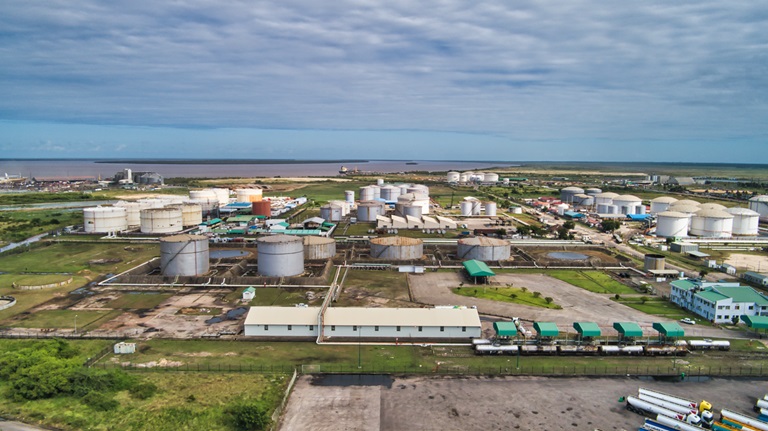Mozambique: ADIN and TotalEnergies sign MoU to promote income generation and job creation in Palma ...
Expansion of the Beira-Harare pipeline ensures the region’s energy needs

Image: Supplied
- Beira corridor guarantees energy security for SADC countries with no access to the coast
The Beira corridor is the main fuel supply route for Zimbabwe and one of the main supply routes for fuels in transit to Zambia and the Congolese region of Catanga.
The integrated assets of CFM (Port of Beira operator), CPMZ (owner/operator of the Mozambican pipeline), PZL (owner/operator of the Zimbabwean pipeline) and NOIC (shipper appointed by the government of Zimbabwe) are a crucial part of the energy infrastructure of the central region of the South African Development Community (SADC), and their safe and efficient operation is vital to ensure the energy security of Mozambique and the landlocked countries in the Beira corridor, including Zimbabwe and Zambia.
Effectively, the energy infrastructure that links the port of Beira to Harare consists of an oil pipeline of approximately 500 kilometres long, powered and served by two pumping stations on the Mozambique side and one on the Zimbabwe side. In addition, the support infrastructure for the Beira corridor includes tank farms at the port of Beira, at Feruka to supply the Manicaland region, and tank farms at Harare to supply local demand from Zimbabwe and position Harare as the regional distribution hub for oil products. The supply of fuel to Zimbabwe is regulated by the Pipeline Operating Agreement signed by CPMZ and the government of Zimbabwe.
Project Cobalt, a shared vision for the Beira corridor
The key to the successful development of a supply corridor is the coordinated approach of the stakeholders based on a common interest and a shared vision. From this perspective, the Beira corridor is an excellent example of collaborative development. In recent years, these stakeholders have proactively sought to position the Beira corridor as the main route for the supply of fuels to markets beyond Zimbabwe, namely Zambia and Catanga (DRC).
After several months of preparatory work throughout 2021, CPMZ and the government of Zimbabwe signed the Memorandum of Understanding that formalises Project Cobalt. This project envisages an action plan in various areas with a common focus: creating the conditions for Harare to assert itself competitively as a central hub for distributing refined oil products to the hinterland. Project Cobalt includes aspects such as dedicating the Mabvuku (Harare) tank farm exclusively to fuel destined for the hinterland and reformulating the process of scheduling, nominating and injecting refined oil products into the pipeline.
According to the CEO of NOIC, Mr Wilfred Matukeni (Herald, 1 February 2024), this project, launched in 2022 in collaboration with CPMZ, was designed to encourage traders to transport fuels to the hinterland markets via pipeline, and resulted in an exponential growth in the volumes in transit to the hinterland that year to 270,000,000 litres (compared to a residual base the previous year).
Coordinated expansion plans
With a view to realising the shared vision for the Beira corridor, the collaborative approach between CPMZ and the government of Zimbabwe has been reinforced by close coordination of the expansion plans for the respective pipelines. In January 2024, CPMZ announced via a press release that its new pumping platforms were already in production, providing the Beira-Feruka pipeline with an installed capacity of 3,000,000 cu.m./year.
For its part, NOIC, through its Chairman Innocent Chiganze, stated at a media briefing on 31 January 2024, just after NOIC’s Annual General Meeting, that the company’s expansion plans include upgrading the installed capacity of the pipeline linking Feruka to Harare, which will culminate in the short term in the same pumping capacity of 3,000,000 cu.m./year in line with the upgrade carried out by CPMZ.
At the moment, both parties are already preparing the next phase of the expansion plan that will enable the Beira-Harare pipeline to expand from 3,000,000 to 5,000,000 cu.m./year.
The completion of the different phases of the expansion project will make it possible to anticipate the growing demand needs of the hinterland and is in line with the strategic vision shared by CPMZ and the government of Zimbabwe: (i) to make the Beira-Harare pipeline the preferred carrier of refined products to the southern Africa hinterland and (ii) to make Harare the reference fuel distribution hub for the hinterland.
Pumping interruptions requested by Zimbabwe pose challenges
The expansion plans announced by both CPMZ and NOIC mean that the Beira corridor pipeline will see its installed capacity increase in 2024 by almost 50% to the above-mentioned 3,000,000 cu.m/year, with the prospect of this capacity rising to 5,000,000 cu.m/year in the near future.
Despite the fact that the new capacity of CPMZ’s pipeline on the Beira-Feruka section has already come online, since the beginning of the year there have been reports about the difficulties the Zimbabwe market is having in absorbing the additional volumes that the CPMZ pipeline is able to transport, which has led to successive requests from NOIC to reduce the flow in the CPMZ pipeline and even to ask for pumping operations to be stopped.
These challenges, which jeopardise the utilisation rate of the new capacity and the profitability of the substantial investments made in the new infrastructure, contrast with recent reports of Zimbabwe’s intention to promote the construction of a second pipeline valued at around one thousand million dollars — the private developer of this pipeline told the Zimbabwe Independent that this project is awaiting the approval of the Mozambican authorities.
At a time when the expansion plans for the current pipeline anticipate and largely satisfy the demand forecasts for the hinterland region, and in a context where Zimbabwe is finding it difficult to absorb the pace of growth of the Mozambican pipeline, the question arises as to the economic rationality of building new infrastructure when the investments made in the current pipeline are far from being realised and made profitable. Such a project would run the risk of accumulating losses for the companies and the governments of Mozambique and Zimbabwe in a scenario of scarce resources and a challenging macroeconomic outlook for both countries.












Leave a Reply
Be the First to Comment!
You must be logged in to post a comment.
You must be logged in to post a comment.